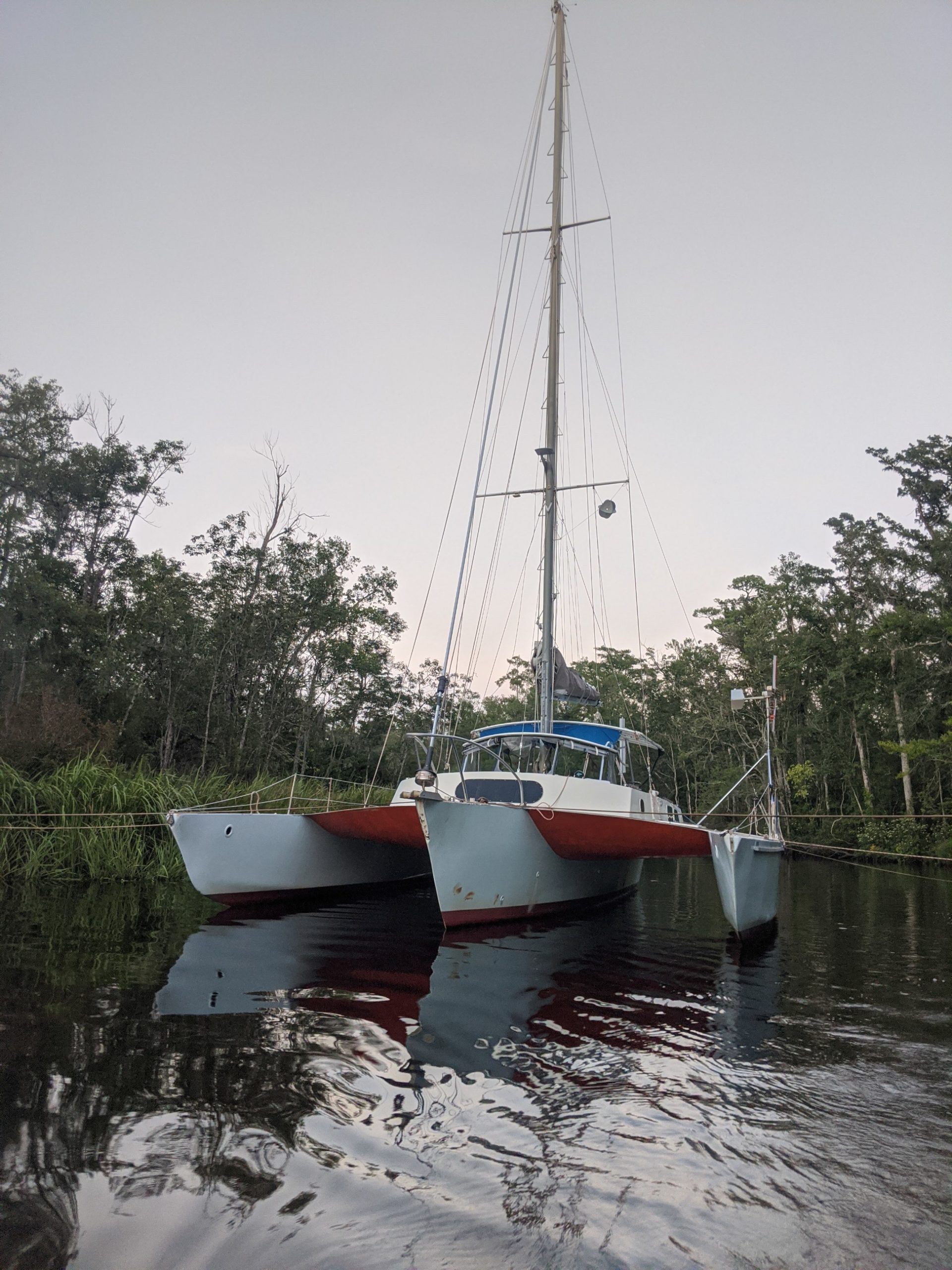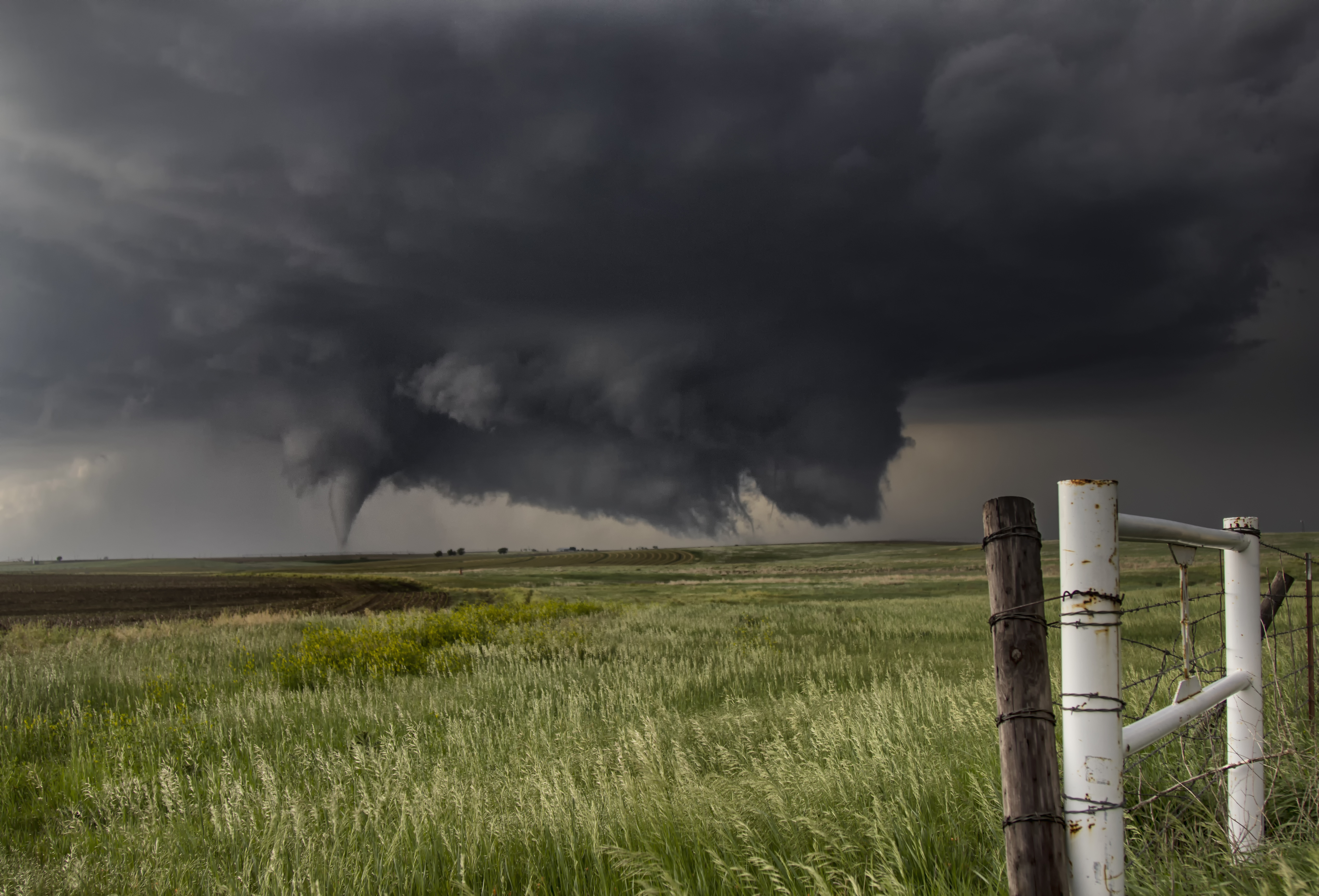.png)
GENERAL BOAT SECURING PRECAUTIONS
In all cases, reducing surface area on your vessel is step one. If you know you won't be using your boat for awhile it's best to remove all covers, canvases, cushions, gear, fuel containers, sails, dinghies, small trolling motors, expensive electronics, etc. Make sure your batteries are fully charged, all electronics are turned off except for the auto bilge, which should be functioning with open drains. Be sure to keep drain plugs open for self-bailing boats so that they don’t become inundated by rain water, flood, and potentially sink. If you're keeping it in the water point the bow out towards open water. It’s the strongest part of the boat and reduces windage. Examine and inspect all cleats, pilings, mooring lines, chains, anchors etc. Old rotten pilings and even old concrete pilings can cause more damage than they prevent. The lateral stress and twisting can snap them in half. Things to be aware of are frayed lines, corrosion, rot, and anything that would potentially weaken an otherwise secure attachment.
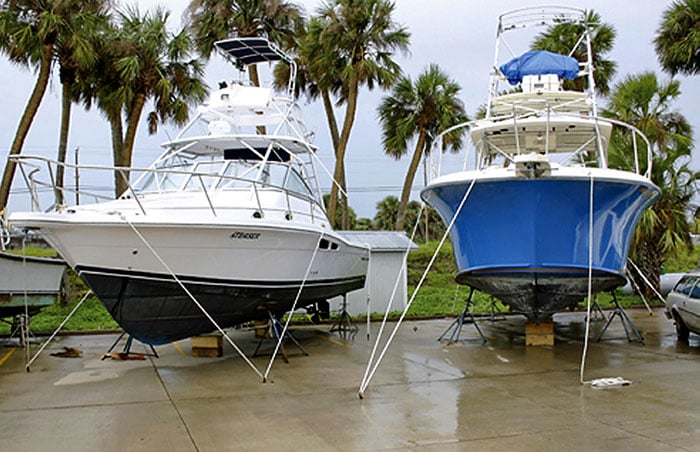
Boats that are hauled out are far less likely to be damaged during a storm than those left in the water. Using straps is effective at keeping boats from toppling over or floating away.
HAUL OUT
You most likely won't have time to haul your boat out before a severe thunderstorm, but if you do, it's your safest bet in preventing damage. Check out what our Marine Manager, Jason Riley, and The Qualified Captain have to say about it...
LINES AND BUMPERS
If you plan on leaving your boat in the water, whether moored or attached to a dock, make sure you have heavier, thicker, and extra lines with plenty of slack and chafing gear attached to accommodate for harder winds, currents, higher tides and storm surge. You will also want to put out all bumpers to account for unknown occurrences. Even if your boat doesn’t bounce off a dock, someone else’s may come loose and get pushed into yours.
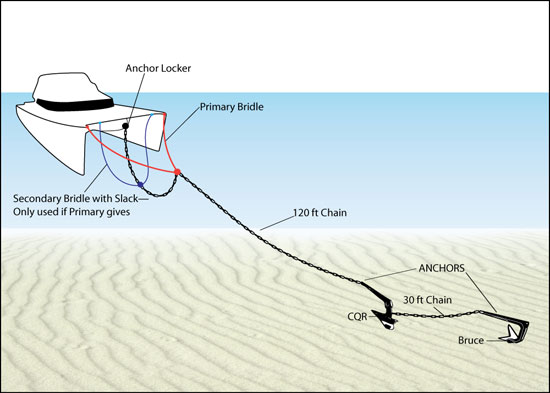
MOORING YOUR BOAT
For a mooring situation, consider a “snug harbor” that is protected on all sides from open fetch. Consider though that storm surge and extreme high tides commonly combine to reach levels ten feet above normal and potentially higher. This may expose an otherwise sheltered harbor to open wind and fetch as sea levels rise above and pour over surrounding sea walls and jetties. If possible, inspect all mooring chains, anchors, couplers, and lines. Consider using extra length on your lines as higher tides will increase the angle of the anchor line and potentially pull free if the ratio becomes too small.
DOCKING YOUR BOAT
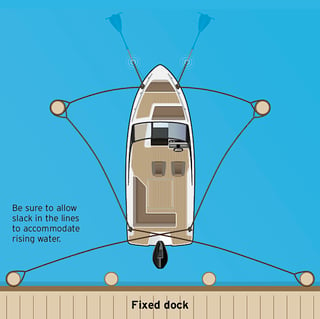

The BoatUS CAT team estimate that better dock line use and arrangement could have saved upwards of fifty percent of damaged boats at fixed docks. Larger longer lines tied properly will protect against chafing and impacts against the docks and pilings.
There’s an old saying that “Those who can’t tie a knot, tie a lot!” If you are unfamiliar with simple strong ways to tie off to a cleat, a piling, etc. we recommend doing a little bit of research on how to properly secure a line, versus creating a rat’s nest of dock lines that ironically will either unravel or never get untangled. That being said, an effective “web” of properly tied dock lines evenly spread provides the most stability in a storm.
Keeping your boat spaced evenly from pilings and the dock itself will prevent damage to the hull, engine, and swimming platforms which are particularly susceptible to causing a loss.
- A floating dock is even nicer because it will rise and fall with the tide. Just be sure to take note of how high the pilings are that it’s collared to. If the tops are only 6 feet above normal tide levels, you should reconsider. The whole dock could float away with your boat in an 8-10’ storm surge.
- If attached to a permanent dock, your lines could be too short. As the tide or flood waters rise, your boat could be forced to list and be held down, causing water to spill over the sides and instantly flood/sink your boat.
Check out this helpful video on how to tie up your boat by BoatUS…
LIFTS
If you’re wondering where not to ever keep your boat during a storm…here’s the answer: Boat lifts!
MARINA STORAGE RACKS
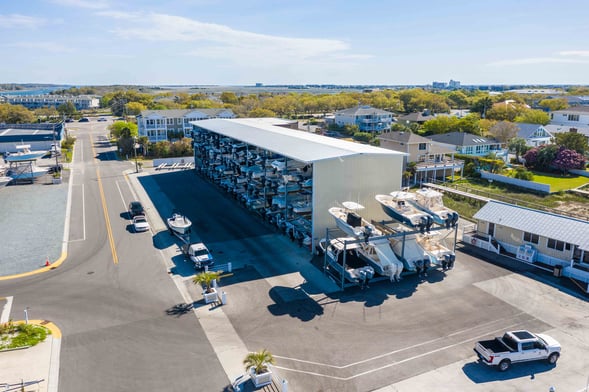
Although they are made of steel, these high-rise racks may not be storm proof. Hurricane Wilma alone caused the collapse of three large storage racks holding thousands of boats. Downbursts and tornadoes can easily cause damage to these metal structures. Newer structures are going to be made with higher standards, but most marinas should know the wind rating for their structures so that you can make an informed decision when the time comes. If it’s an older structure, consider pulling it down.
CANALS AND RIVERS
You may or may not have time to find a “hurricane hole” up in a sheltered waterway such as a river or canal which can provide protection for vessels. Depending on whether you are in a neighborhood canal or up in a tributary of a local river, suspending your boat in the middle a web of mooring lines can provide much more protection than being left at a dock. Just make sure the bow is facing towards the entrance of the waterway and that you’re not obstructing a navigable waterway. This can be achieved using both sides of the canal or a combination of anchors and lines tied to trees on shore.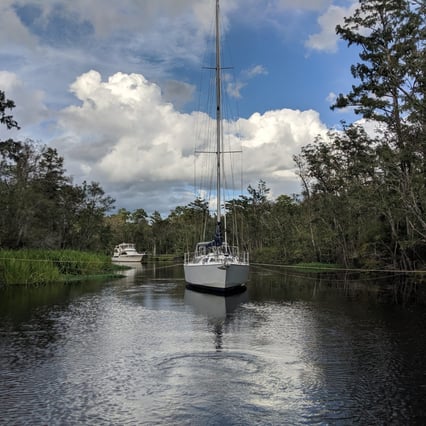
We are all aware that we live in a hurricane prone stretch of coast, but what is often overlooked is the fact that we also live in a very thunderstorm prone area. Here are some "fun" facts about thunderstorms from the National Weather Service and NASA:
1. An estimated 16 million thunderstorms occur on Earth every year.
2. At any given time, there are about 2,000 thunderstorms in progress.
3. Thunderstorms can produce damaging straight-line winds, hail, heavy rain, deadly lightning and tornadoes.
4. In the United States alone, an estimated 100,000 thunderstorms occur each year.
5. Of those 100,000 thunderstorms in the U.S., about 10% are classified as severe, producing either damaging winds or wind damage, large hail and/or tornadoes.
6. There are four main types of thunderstorms: single-cell, multi-cell cluster, multi-cell line (squall line) and supercell.
7. The average thunderstorm is 15 miles wide and lasts around 30 minutes.
8. Lightning forms due to the collision of ice crystals and water droplets within clouds creating positive and negative electric charges, which become separated by convective forces. A lightning bolt dispenses from the cloud when the charges become separated enough.
9. Some 25 million lightning strikes are recorded in the U.S. each year.
10. Most lightning in the U.S. occurs during the summer, but people can be struck any time of the year.
11. Lightning kills an average of 26 people a year in the U.S. (2010 to 2019 data) and injures hundreds more. Some survivors suffer lifelong neurological damage.
12. There is no safe place outdoors when you hear thunder, so you should move indoors immediately.
13. Other planets in our solar system also have lightning, including gas giants Jupiter and Saturn. There are also bright flashes in dust storms on Mars, which some scientists believe to be evidence of lightning.
STAY INFORMED: EMERGENCY NOTIFICATIONS
You can receive alerts and warnings directly from the National Weather Service for all hazards with a NOAA Weather Radio (NWR). Some radio receivers are designed to work with external notification devices for people who are deaf or hard of hearing. For more information on NWR receivers, visit nws.noaa.gov/nwr/info/nwrrcvr.html.
Sign up for emergency alerts and notifications that your community may offer. Download Be Smart.
Know Your Alerts and Warnings for a summary of notifications at ready.gov/prepare.
One more very important point that we would like to get across and always keep in mind when discussing storms and insuring your vessel, dock, marina, etc., please don’t wait till that storm watch or warning is in effect to make moves. Once a storm warning or watch is in effect for a certain area, your own personal safety is much more important and you should take shelter somewhere safe. You will have to wait until that watch or warning has been lifted or the storm has passed.
If you have questions regarding storms and how it pertains to your boat, dock, or marine insurance please feel free to reach out us insurance@wellsins.com or 910.762.8551


